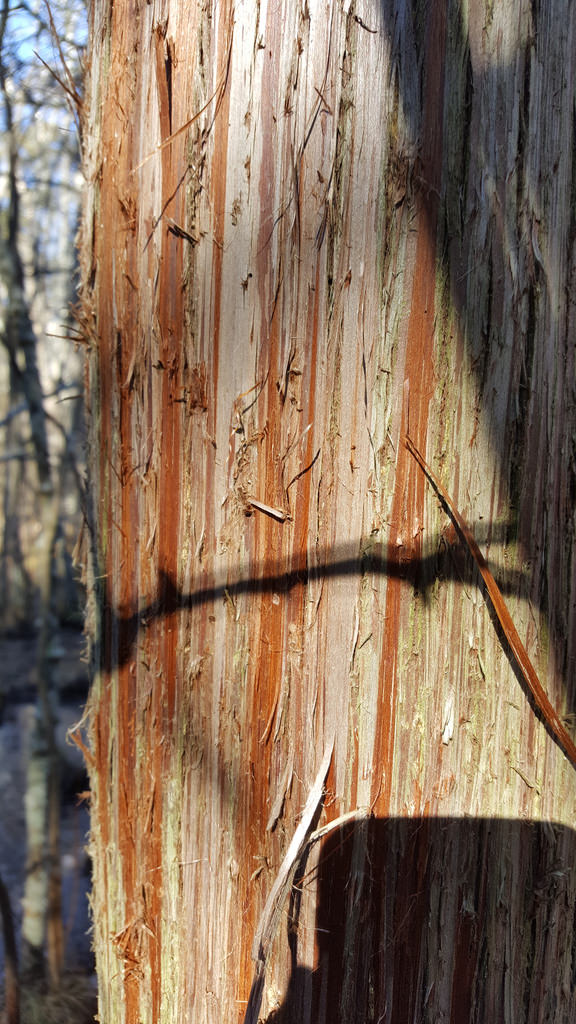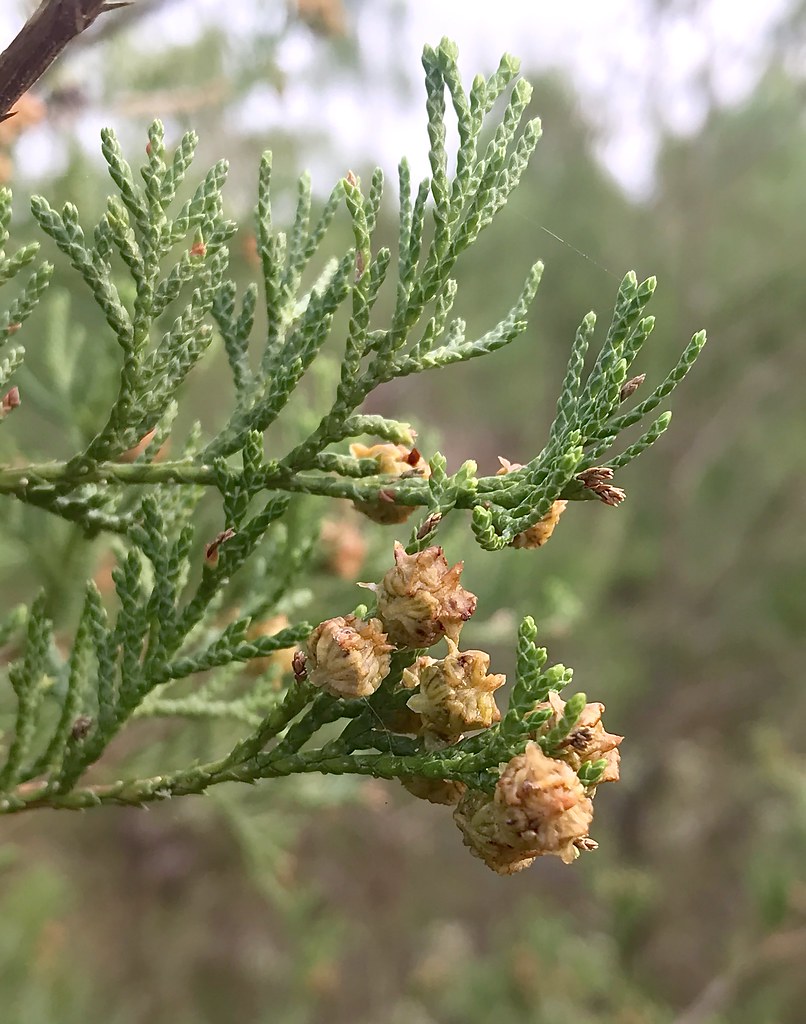Atlantic White Cedar
Chamaecyparis thyoides [L.] Britton, Sterns & Poggenb.
Description
Atlantic white cedar is a member of the cypress family (Cupressaceae). It is an evergreen tree that grows up to 75 feet tall and averages a lifespan of 200 years, though it can live up to at least 1,000 years¹. The oldest of these cedars are rarely found in local and developed areas and are usually found in habitats that are undisturbed². This evergreen has scaly, flattened bluish-green leaves³ which have a fan-like arrangement4 and grows blue or brown spherical cones5 . Atlantic white cedars use pollen from their cones to reproduce, and does so once a year during spring6.

Bark of Atlantic white cedar. B. Hubick, Maryland Biodiversity Project17

Scale leaves and seed cones of Atlantic white cedar. J. Brighton, Maryland Biodiversity Project17
Distribution
Atlantic white cedar occurs north to south along the Atlantic and Gulf Coasts from southern Maine to northern Florida7 and west to Mississippi 8. It grows in wet sites such as swamps, marshes, and riverbanks¹ and is seldom found at elevations above 50 meters ³. In Maryland, Atlantic white cedars grows in the lower Eastern shore and Anne Arundel County 10. 
Natural distribution of Atlantic white ceda18
Wildlife Importance
This evergreen tree has significant importance to wildlife. It maintains swampy ecosystems by stabilizing stream flows and filtering water ². It removes carbon from the air as well as provides habitat for birds, mammals, and insects. White-tail deer feed on the twigs and foliage of the tree while mammals like mice and rabbits feed on the seedlings12 . Songbirds also use this tree as a food source¹. There is a symbiotic relationship between the Atlantic white cedar and the Hessel’s Hairstreak Caterpillar. The foliage of the Atlantic white cedar resembles the pattern on the caterpillars and is the sole food source for the rare caterpillar6.
Economic Importance
Atlantic white cedar has been used for many economic purposes. . It has been logged for fuel and charcoal and widely used for building7,16 . Ships were built using the lumber of the white cedar and were also used to make barrels, shingles and tubs². As of now, white cedar is currently used to make telephone poles, boat railing, and lawn furniture11 .
Atlantic white cedar has been reduced by draining habitats and clearcutting7. It is relatively resistant to diseases and insects 7. Atlantic white cedar forests are susceptible to storm surge and salt water intrusion due to climate change. This leaves “ghost forests” that were subjected to salt water and died9. Crown fires generally kill Atlantic white cedar14.
Interesting Facts
- Atlantic white cedar is a member of the cypress family and is not related to either red cedar or Northern white cedar16.
- During the Revolutionary War, charcoal made from the tree was used to make gunpowder¹.
- The largest Atlantic white cedar in Maryland measures 37 inches in diameter and is found in Worcester County13.
References
-
- Chesapeake Bay Program: Atlantic white cedar
- The Nature Conservancy: Planting Atlantic white cedar
- American Conifer Society: Chamaecyparis thyoides
- bplanting.org: Atlantic white cedar vs eastern red cedar
- The Gymnosperm Database: Chamaecyparis thyoides
- Kiddle: Chamaecyparis thyoides facts for kids
- USDA Forest Service Fire Effects Information Service: Chamaecyparis thyoides
- Maine Natural Areas Program: Chamaecyparis thyoides
- New Jersey Department of Environmental Protection
- Bay Journal: Atlantic white cedars helped to build nation, now need help rebuilding their population
- USDA NRCS Plant Guide: Atlantic white cedar
- Classification of the Natural Communities of Massachusetts: Northern Atlantic white cedar swamp
- Maryland Big Trees
- USDA Forest Service Silvics, Vol. 2–Hardwoods: Chamaecyparis thyoides
- New York Natural Heritage Program: Coastal plain Atlantic white cedar swamp
- Mousum Way Land Trust
- Maryland Biodiversity Project: Atlantic white cedar
- Wikimedia Commons: Chamaecyparis thyoides
Contributed by A. Kotlinsky and P. Odeh
